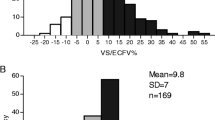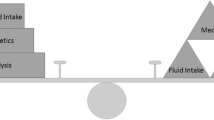Abstract
Objective
To determine the effects of acute hypertonic mannitol infusion on intravascular volume expansion and to identify potential predictors of hypervolemia.
Design
Measurements of plasma volume and volume regulatory hormones were performed in healthy volunteers before and over 90 min after acute infusion of 20 % mannitol solution in a therapeutic dose of 0.5 g/kg body weight, equalling an average infusion volume of 180 ml.
Setting
Clinical research unit in an 800-bed teaching hospital in the eastern part of Switzerland.
Participants
Eight normal male volunteers.
Measurements and results
Baseline plasma volume was determined by the indocyanine green dye dilution technique. Serial plasma protein measurements were performed after mannitol infusion to calculate intravascular volume changes. Mannitol administration resulted in a plasma expansion that persisted for more than 90 min and peaked at 112 % of the baseline plasma volume 15 min after infusion. Concomitantly, an increase in systolic blood pressure and a fall in plasma sodium concentration occurred. Pharmacokinetic analyses of mannitol distribution and elimination revealed a close relation between plasma volume expansion and mannitol serum concentrations. While renin activity and aldosterone concentrations were suppressed proportionally to the intravascular volume increase, antidiuretic hormone was increased despite notable volume expansion and hyponatremia. Similarly, a rise in atrial natriuretic peptide was detected.
Conclusions
Therapeutic doses of hypertonic mannitol cause substantial plasma volume expansion, resulting in increased blood pressure. Plasma volume expansion is related to mannitol serum concentrations and mannitol clearance determines the time required to restore normovolemia. ADH and ANP are potentially aggravating factors of mannitol-induced hyponatremia.
Similar content being viewed by others
References
Cottrell JE, Robustelli A, Post K et al. (1977) Furosemide-and marmitol-induced changes in intracranial pressure and serum osmolality and electrolytes. Anesthesiology 47:28–30
Dorman HR, Sondheimer JH, Cadnapaphornchai P (1990) Mannitol-induced acute renal failure. Medicine 69: 153–159
Rabetoy GM, Federicks MR, Hostettler CF (1993) Where the kidney is concerned, how much mannitol is too much? Ann Pharmacother 27: 25–28
Lang F (1987) Osmotic diuresis. Renal Physiol 10:160–173
Kamoi K, Sato F. Arai O, Ishibashi M, Yamaij T (1988) Effects of plasma volume and osmolality on secretion of atrial natriuretic peptide and vasopressin in man. Acta Endocrinol 118:51–58
Yamasaki Y, Nishiuchi T, Kojima A, Saito H, Saito S (1988) Effects of an oral water load and intravenous administration of isotonic glucose, hypertonic saline, mannitol and furosemide on the release of atrial natriuretic peptide in men. Acta Endocrinol 119: 269–276
Uretsky BF, Verbalis JG, Srinivas M et al. (1990) Control of atrial natriuretic peptide secretion in patients with severe congestive heart failure. J Clin Endocrinol Metab 71:146–151
Kurnik BRC, Lawrence SW, Askenase AD, Kurnik PB (1991) Mannitol stimulates atrial natriuretic peptide release in humans. Am J Kidney Dis 17: 62–68
Zerbe RL, Robertson GL (1983) Osmoregulation of thirst and vasopressin secretion in human subjects: effects of various solutes. Am J Physiol 244:E607-E614
Knapp DR (1979) Handbook of analytical derivatization reactions. Wiley, New York
Bartels H, Cikes M (1969) Chromogens in the creatinine determination of Jaffé. Clin Chim Acta 26:1–10
Bradley EC, Barr JW (1968) Determination of blood volume using indocyanine green (Cardio green) dye. Life Sei 7:1001–1007
Thompson WO, Thompson PK, Dailey ME (1988) The effect of posture upon the composition and volume of the blood in man. J Clin Invest 5: 573–609
Shumaker RC (1986) PKCALC: A BASIC interactive computer program for statistical and pharmacokinetic analysis of data. Drug Metab Rev 17: 331–348
Lang RE, Thölken H, Ganten D, Luft FC, Ruskoaho H, Unger T (1985) Atrial natriuretic factor: a circulating hormone stimulated by volume loading. Nature 314:264–266
Weder AB, Sekkarie MA, Takiyyuddin M, Schork NJ, Julius S (1987) Antihypertensive and hypotensive effects of atrial natriuretic factor in men. Hypertension 10: 582–589
Levy M, Cernacek P (1993) Urinary sodium excretion in chronic caval dogs after combined infusions of mannitol and ANP. Am J Physiol 264:F206–211
Author information
Authors and Affiliations
Corresponding author
Rights and permissions
About this article
Cite this article
Arabühl, P.M., Ballmer, P.E., Krähenbühl, S. et al. Quantification and predictors of plasma volume expansion from mannitol treatment. Intensive Care Med 23, 1159–1164 (1997). https://doi.org/10.1007/s001340050473
Received:
Accepted:
Issue Date:
DOI: https://doi.org/10.1007/s001340050473




